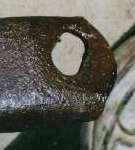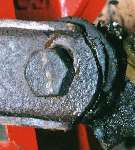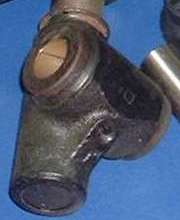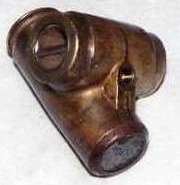The MGA With An Attitude
SWIVEL LINK LUBRICATION - A-arm Wear - FS-108
At 05:39 AM 12/11/04 +0000, Mitch from the Twin Cam Group wrote:
>"Has anyone come up with a modification to the A Arms, to prevent the trunnion bolts from wearing big oval holes in the A arms?"


No modification is necessary. They just have to be installed properly and greased regularly. My MGA has accumulated 340,000 miles and still has the original factory issue a-arms, never having needed repair or replacement (just new bushings occasionally).
The steel tube which runs inside of the bronze liner bushing is a whisker longer than the width of the swivel link. When you pull the trunnion bolt up tight it clamps the steel tube securely between the wishbone arms, along with seal supports and thrust washers, and holds all of those parts in rigid assembly so the bolt cannot move in the arms. The swivel link with the bronze bushing then rotates on the steel tube as the suspension moves. As long as you keep it properly greased, all is well.
If the bolt was left loose, then the steel tube and the bolt could move about in the arm brackets. That would cause the noted wear, but this case is generally rare, being a case of negligence in assembly.
The problem almost always comes when the lube job is neglected, and there is eventually no grease in between the bronze bushing and the steel distance tube. If the car is driven regularly so it can not seize up, then the bronze bushing wears out from lack of grease, and the bushing joint gets loose and sloppy, but the bolt and the a-arms still survive.
If the car is parked for a long time, the grease might dry out and glue the joint together. Or if the seals are bad (very common) and water gets into the joint and the car is parked for a while, then the joint can accumulate rust on the steel tube. These things can effectively glue/weld the steel tube to the bronze bushing. If that joint is then tight enough, the next time the car is driven it can force rotation of the steel tube and wrench it loose from the a-arm assembly. In that case the bolt will rotate in the holes in the a-arms, and the resulting wear will neck down the bolt and oval the holes in the arms.
There is a trick for proper greasing of this joint. There is only a single grease fitting on the swivel link to inject grease inside. The grease needs to go three directions at once. It needs to go front and back to lube both ends of the horizontal bushing. It also needs to go up the threaded joint of the swivel pin to lube the steering motion axis. If one of these directions provides significantly more resistance to flow, it may get no grease while the grease goes in another direction(s).
To improve the odds of grease going in all the right directions at once you need to relieve the mechanical load on the link. To do this, place a floor jack under the a-arm, directly under the coil spring, and lift the wheel off the floor. The weight of the car will then be held exclusively on the coil spring. This unloads all of the suspension and steering joints except the inner end of the a-arm (which is mounted with rubber bushings). Then when grease is injected into the swivel link it has the best chance of moving out in all three directions at once.


 It is important to be sure that the grease actually does go all three directions at the same time. The only way you can be sure of this is to see grease being expelled past the seals, or to see the seals being expanded from the grease inside. Once you verify this, then you can squeeze the seals with your fingers to expel excess grease and re-seat the seals, and wipe off any expelled grease with a rag. If you cannot get the grease to go all three ways at once, that is the time to disassemble the joint for cleaning if necessary, before it wears out from lack of lubrication.
It is important to be sure that the grease actually does go all three directions at the same time. The only way you can be sure of this is to see grease being expelled past the seals, or to see the seals being expanded from the grease inside. Once you verify this, then you can squeeze the seals with your fingers to expel excess grease and re-seat the seals, and wipe off any expelled grease with a rag. If you cannot get the grease to go all three ways at once, that is the time to disassemble the joint for cleaning if necessary, before it wears out from lack of lubrication.
While you have the suspension unloaded in this fashion, it is a good time to shake the wheel and see if any of the suspension joints might wiggle, which would be indication of a worn joint in need of repair. If you do this regularly along with normal preventive maintenance, then the a-arms should never encounter a loose trunnion bolt or oval holes.
Notice in the pictures above that the Welch plug closing the end of the swivel hole is blank with no breather hole. The picture an left came from MG TD suspension. Some very early MGA 1500 cars also had these bronze parts. The picture on right came from MGA 1600 suspension (a disc brake car). My MGA 1500 produced in August 1957 also has iron swivel links with no hole in the Welch plug. Some car did however have a small breather hole in the center of the plug, and it is apparently fairly common. It is not known which cars did or did not have the breather hole. This feature may have come and gone at various times during production. The parts seem to function well with or without the hole, and there is some advantage to having no hole.
When you lube the swivel links it is desirable for the grease to travel in three directions to come out both ends of the bushing and at the unplugged end of the thread. It is more likely for grease in the right directions if there is no hole in the plug. In any case an open hole invites grease to be expelled through the hole when you would like it to go in other directions. If you have swivel links with a vented plug you can change then to blank plugs to good advantage.
|